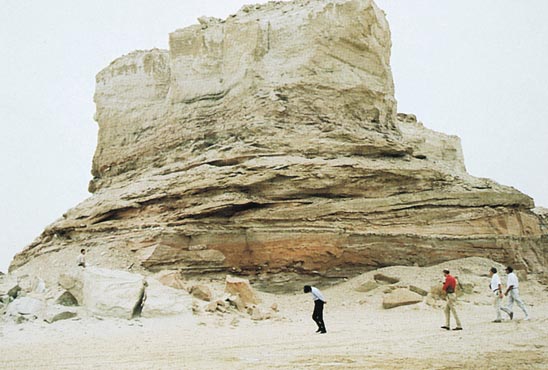
This Article From Issue
July-August 2000
Volume 88, Number 4
DOI: 10.1511/2000.29.0
Fossil Vertebrates of Arabia: With Emphasis on the Late Miocene Faunas, Geology, and Palaeoenvironments of the Emirate of Abu Dhabi, United Arab Emirates. Peter J. Whybrow and Andrew Hill, eds. xxv + 523 pp. Yale University Press, 1999. $125.
During the mid-Tertiary, migration routes between Africa and Eurasia were lost and gained, with the Arabian Peninsula acting as an important corridor. One major theme of the present volume—and certainly the subject of greatest appeal to readers—is the biogeographic importance of this region.

From Fossil Vertebrates of Arabia
Much of this volume presents results of two expeditions carried out in conjunction with local geologists, starting in the 1970s: one led by the editors, Peter Whybrow of the Natural History Museum in London and Andrew Hill from Yale, the other by Herbert Thomas of the Laboratoire de Paléoanthropologie et Préhistoire, Collège de France, Paris. The editors, who are also authors on many of the papers, are to be complimented on bringing so many disciplines together in one volume.
The major focus of the book is the geology and paleontology of the upper Miocene Baynunah Formation, Emirate of Abu Dhabi, which lies at the eastern end of the Arabian Peninsula. Seven chapters deal with the geology, two with the invertebrates, and 13 with the vertebrates of the Baynunah and surrounding formations. Quite frankly, the quality of the fossil vertebrates presented here is not very great. (One five-page chapter is devoted to a single, unidentified cercopithecid lower canine.) Nevertheless, the authors on the whole do a very good job identifying and illustrating the material and placing it in a broader biostratigraphic and biogeographic context.
The section of the book that should have the widest appeal consists of seven chapters offering nice summaries of paleoceanography and terrestrial vertebrate fauna and flora. Although dry by their very nature, the chapters on the fauna, flora and localities of the Baynunah Formation (chapter 23) and fauna, flora and localities for the combined sites in Arabia (chapter 33) are important syntheses. These are certainly the chapters to which I would first turn for general information or in tackling the fossil contents of this tome. There are a few chapters (for example, those on dinosaurs and stone tools) that seem an afterthought to the present volume.
This is an extremely well-produced volume with high-quality figures and photographs, some in color. Its relatively high cost and quite specialized subject matter, however, will deter many readers.—J. David Archibald, Department of Biology, San Diego State University
American Scientist Comments and Discussion
To discuss our articles or comment on them, please share them and tag American Scientist on social media platforms. Here are links to our profiles on Twitter, Facebook, and LinkedIn.
If we re-share your post, we will moderate comments/discussion following our comments policy.